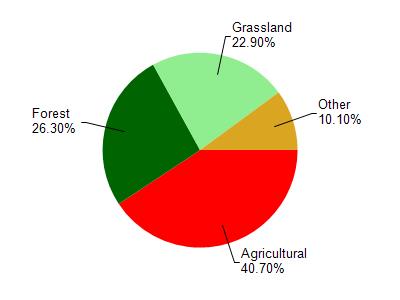Pierce
Yes
No
No
Fish and Aquatic Life
Overview
The headwaters of Isabelle Creek origniate within the town of Ellsworth in Pierce County and flows for about 13 miles before discharging into the Mississppi River at Bay City. From its mouth to 7.6 miles upstream Isabelle Creek is considered a Class II Trout stream. Further upstream is classified as a Class III Trout water.
Date 2011
Author Aquatic Biologist
General Condition
The headwaters of Isabelle Creek were assessed for bugs and fish in 2020 and communities appeared in poor health, but this segment is designated as limited aquatic life and is not expected to support many bugs or fish. This portion of the stream is not considered impaired.
Date 2019
Author Ashley Beranek
Condition
Wisconsin has over 84,000 miles of streams, 15,000 lakes and milllions of acres of wetlands. Assessing the condition of this vast amount of water is challenging. The state's water monitoring program uses a media-based, cross-program approach to analyze water condition. An updated monitoring strategy (2015-2020) is now available. Compliance with Clean Water Act fishable, swimmable standards are located in the Executive Summary of Water Condition in 2018. See also the 'monitoring and projects' tab.
Reports
Recommendations
Monitor Aquatic Biology
Conduct biological (mIBI or fIBI) monitoring on Isabelle Creek, WBIC: 2445000, AU:16327
Management Goals
Wisconsin's Water Quality Standards provide qualitative and quantitative goals for waters that are protective of Fishable, Swimmable conditions [Learn more]. Waters that do not meet water quality standards are considered impaired and restoration actions are planned and carried out until the water is once again fishable and swimmable
Management goals can include creation or implementation of a Total Maximum Daily Load analysis, a Nine Key Element Plan, or other restoration work, education and outreach and more. If specific recommendations exist for this water, they will be displayed below online.
Monitoring
Monitoring the condition of a river, stream, or lake includes gathering physical, chemical, biological, and habitat data. Comprehensive studies often gather all these parameters in great detail, while lighter assessment events will involve sampling physical, chemical and biological data such as macroinvertebrates. Aquatic macroinvertebrates and fish communities integrate watershed or catchment condition, providing great insight into overall ecosystem health. Chemical and habitat parameters tell researchers more about human induced problems including contaminated runoff, point source dischargers, or habitat issues that foster or limit the potential of aquatic communities to thrive in a given area. Wisconsin's Water Monitoring Strategy was recenty updated.
Grants and Management Projects
Monitoring Projects
| WBIC | Official Waterbody Name | Station ID | Station Name | Earliest Fieldwork Date | Latest Fieldwork Date | View Station | View Data |
|---|
| 2445000 | Isabelle Creek | 10009139 | 5-Isabelle Creek-620th Street | 7/2/2012 | 1/1/2015 | Map | Data |
| 2445000 | Isabelle Creek | 10044425 | Isabelle Creek - 1000' below bridge in N1/2 N1/2 NW1/4 of S15 | | | Map | Data |
| 2445000 | Isabelle Creek | 10034836 | Isabelle Creek at Lowest 620th Crossing | 10/6/2011 | 1/1/2015 | Map | Data |
|

Watershed Characteristics
Isabelle Creek is located in the Trimbelle River and Isabelle Creek watershed which is 221.40 mi². Land use in the watershed is primarily agricultural (40.70%), forest (26.30%) and a mix of grassland (22.90%) and other uses (10.10%). This watershed has 467.20 stream miles, 1,912.55 lake acres and 3,854.20 wetland acres.
Nonpoint Source Characteristics
This watershed is ranked High for runoff impacts on streams, Not Ranked for runoff impacts on lakes and High for runoff impacts on groundwater and therefore has an overall rank of High. This value can be used in ranking the watershed or individual waterbodies for grant funding under state and county programs.However, all waters are affected by diffuse pollutant sources regardless of initial water quality. Applications for specific runoff projects under state or county grant programs may be pursued. For more information, go to surface water program grants.